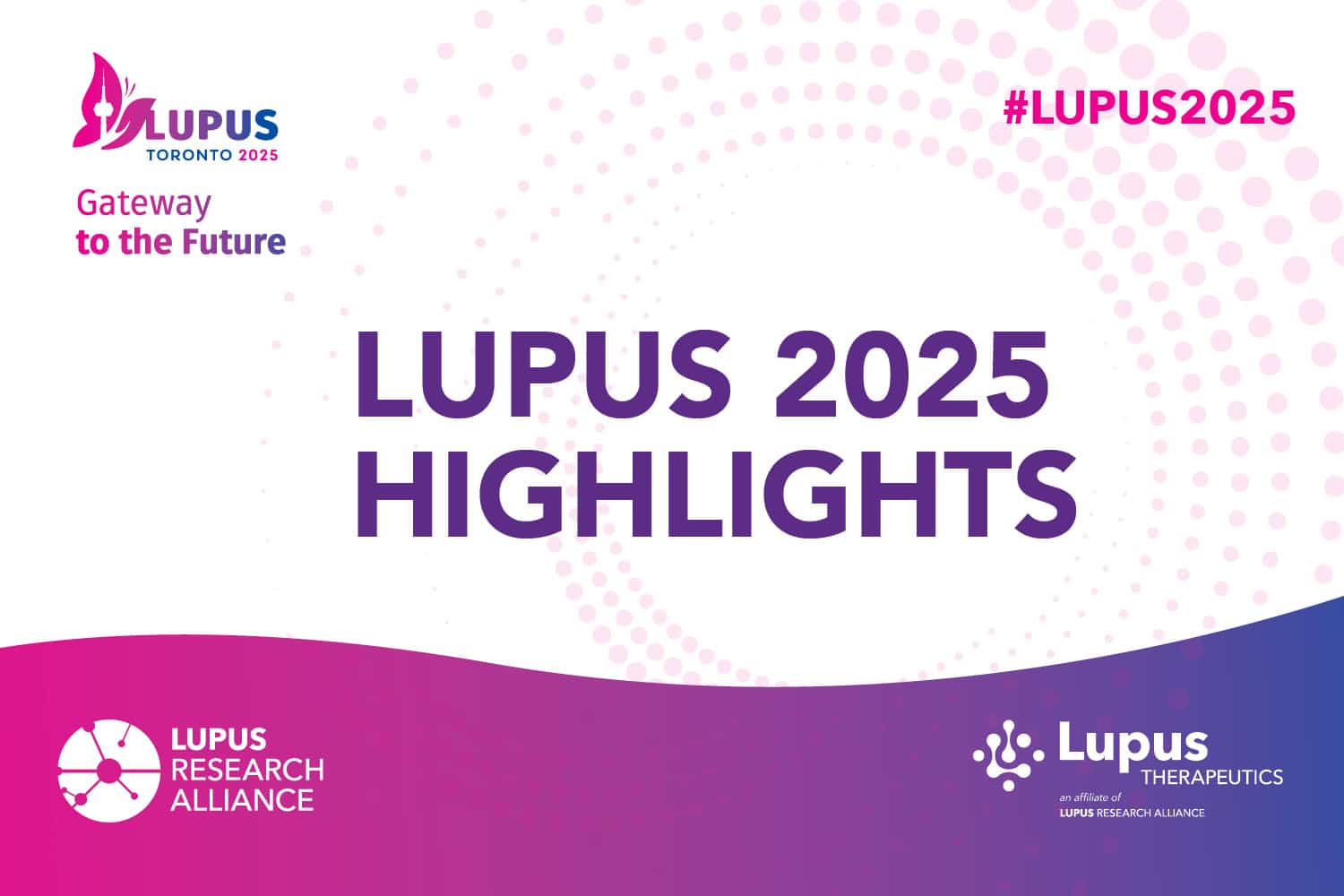Breadth of Clinical Research Presented at the 2019 ACR/ARP Annual Meeting Brings Hope for New Lupus Treatments

Breadth of Clinical Research Presented at the 2019 ACR/ARP Annual Meeting Brings Hope for New Lupus Treatments
November 14, 2019
The Lupus Research Alliance staff was on the ground at the 2019 ACR/ARP Annual Meeting and highly encouraged by the positive results reported for several potential new treatments that may help people with lupus.
“The foundational work the Lupus Research Alliance and others have supported is beginning to bear fruit with potential therapies like anifrolumab, obinutuzumab, and cenerimod showing positive results in Phase 3 and 2 clinical trials. Importantly, exciting pre-clinical data offer further promise for additional therapies and biomarkers for lupus in the near future,” noted Teodora Staeva, PhD, Chief Scientific Officer at the Lupus Research Alliance.
Following are summaries of the clinical study results just out from ACR:
Anifrolumab — Results reported by AstraZeneca of the second late-stage Phase 3 trial called TULIP-2 showed the effectiveness of their investigational treatment, anifrolumab, for reducing disease activity. The LRA is particularly interested in anifrolumab, having supported numerous studies identifying and unraveling the interferon pathway that anifrolumab targets.
“The phase 3 TULIP 2 presentation was the highlight of the ACR meeting for the lupus community,” noted Dr. Mary Crow, LRA Scientific Advisory Board Co-chair and Physician-in-Chief/Chair of the Department of Medicine at Hospital for Special Surgery. “Dr. Eric Morand’s presentation acknowledged the high significance of a positive phase 3 lupus clinical trial. What was particularly gratifying for me and for the LRA was his expression of thanks to the “basic scientists” who generated the research that documented the type I interferon pathway as a significant pathogenic mechanism in SLE.”
Using an outcome measure termed the British Isles Lupus Assessment Group (BILAG)-based Composite Lupus Assessment (BICLA), anifrolumab met its primary endpoint, meaning that treatment with anifrolumab resulted in significant and meaningful reduction in disease activity in all organs with no new flares. As measured by BICLA, 47.8 percent of patients responded to treatment with anifrolumab compared with 31.5 who received placebo. The rate of flares was also somewhat lower among those treated with anifrolumab.
The study also succeeded in meeting key secondary endpoints: 51.5 percent of those treated with anifrolumab were able to reduce their doses of the steroid prednisone versus 30.2 percent taking placebo. According to another standard measurement tool, 49 percent of patients showed improvement in severity and degree of skin damage compared with 25 percent of those on placebo.
No new information on safety was identified.
Results were also reported by principal investigator Dr. Richard Furie from the other anifrolumab Phase 3 trial called TULIP-1. The outcome of this study was disclosed last year, but the data were not revealed until the ACR presentation and a simultaneous publication in the journal Lancet Rheumatology. While the primary endpoint in this study was not met, several secondary endpoints suggest a clinical benefit of the drug compared to placebo.
Dr. Crow noted, “Dr. Furie suggested a very thoughtful and well-informed proposal: that the FDA consider shifting their approach to assessment of lupus clinical trials from one that requires assignment of a pre-determined primary outcome measure to a more flexible approach. For example, they might judge a trial to show efficacy if the majority of a group of validated outcome measures was met in a particular clinical trial. Our goal should be to increase the number of agents that gain FDA approval, as combination therapy with several agents might ultimately be the best therapeutic approach.”
Obinutuzumab (Gazyva®) – The Phase 2 NOBILITY trial showed that Genentech’s type II anti-CD20 monoclonal antibody obinutuzumab improved responses in proliferative lupus nephritis, the most severe form of kidney damage caused by lupus. In combination with standard of care, obinutuzumab more than doubled the percentage of lupus nephritis patients achieving complete renal response, compared to standard of care and placebo.
The NOBILITY trial met its primary endpoint demonstrating success meaning that after one year, 34.9 percent of patients treated with obinutuzumab plus standard of care showed complete renal response to treatment compared with 22.6 percent of those who received placebo. Patients treated with Gazyva showed increasing rates of complete renal response from week 52 to week 76, with 40 percent of patients in the Gazyva group achieving complete renal response, compared to 18 percent of patients in the placebo group at week 76.
Key secondary endpoints were also met; 55.6 percent of patients treated with obinutuzumab experienced either complete or partial improvement compared with 35.5 percent of those receiving placebo. Significant improvements were also seen in reducing levels of antibodies in the blood, another secondary endpoint to measure effectiveness. The study is continuing to evaluate these same measurements at two years.
Cenerimod – Another investigational compound, cenerimod, showed promise in a Phase 2, double-blind, placebo-controlled study presented by Dr. Viktoria Hermann from Idorsia Pharmaceuticals. Cenerimod significantly lowered the number of lymphocytes, a type of white blood cell circulating in the blood and lymph tissue, that in lupus attack rather than protect the body. The analysis also showed a reduction in disease activity and harmful antibodies as measured by the standard evaluation tool SLEDAI-2K. Idorsia announced that the company is currently conducting a further study to evaluate the safety and effectiveness of cenerimod at varying doses for patients with moderate to severe active lupus.
Belimumab (Benlysta®) – Data on various studies of belimumab was shared in three oral presentations and eight posters. One that captured the most attention was the EMBRACE study which looked at the effectiveness and safety of belimumab plus standard of care among black patients with SLE. This presentation reported on data showing it was beneficial among black patients with high disease activity and effects on the kidneys after one year of treatment.
Patients treated with belimumab had a 46 percent lower risk of a kidney flare compared with those given placebo. Among patients who had an elevated level of protein in the urine (proteinuria), a greater number experienced a return to normal levels. No new safety concerns were identified.
Benlysta® was approved as a treatment for lupus in 2011, but GSK was asked by the U.S. Food and Drug Administration to conduct further tests to confirm its effectiveness for black patients.
Ustekinumab (Stelara®) – A drug that the Lupus Research Alliance recommended for testing the potential benefit for lupus – ustekinumab – had previously showed positive results in a Phase 2 clinical trial. Studies reported at the 2019 ACR meeting explore in depth the effects of this drug and how it works in patients.
Through its drug repurposing program, the Lupus Research Alliance first identified ustekinumab as a potential treatment for lupus and encouraged Janssen to pursue testing for this use.
The first study examined the relationship of disease activity responses measured by the assessment tool, Cutaneous Lupus Erythematosus Disease Area & Severity Index (CLASI) vs. mucocutaneous disease responses measured with another instrument (outcome measure) Systemic Lupus Erythematosus Disease Activity Index 2000 (SLEDAI-2K). This analysis of the data after the conclusion of the Phase 2 trial showed that more patients treated with ustekinumab than those receiving placebo had at least 50 percent improvement in effects on the skin as measured by CLASI. The importance of this study is in demonstrating a stronger effect of the drug on skin improvement than previously recognized. Study investigators reported that these results will be confirmed in an ongoing Phase 3 clinical trial of ustekinumab in SLE. Stelara® is not approved for the treatment of lupus but is approved by the FDA for certain autoimmune diseases.
Results of a mechanistic ustekinumab study presented at the meeting looked at how the drug actually works. The investigators identified the presence of a unique set of markers in the blood of patients in the original Phase 2 trial who responded to ustekinumab treatment. Importantly, this signature was not present in the patients who did not respond to the drug. These findings are significant as they pave the way for personalized treatment in the future where patients who are likely to respond to this therapy can be treated with it while those who are not likely to respond can be offered alternative therapies. Another important finding from the study substantiates that the drug is targeting the right pathway.
CD6-ALCAM – The Lupus Research Alliance is particularly excited to see the positive results of one pre-clinical study that leverages LRA-funded foundational work by Chandra Mohan to explain the role of the protein ALCAM in causing inflammation in lupus nephritis. In this study, researchers were able to identify levels in urine of ALCAM and another protein CD6 (usually found on the surface of T cells) that is also central to the inflammation process and binds ALCAM.
Since currently surgical biopsy of kidney tissue is needed to monitor disease activity, trial researchers compared an analysis of biopsies from patients with lupus nephritis and people without lupus. The analysis showed that T cells in the kidneys of people with lupus nephritis express CD6 and the number of those cells is higher than kidney biopsies than in healthy controls. The level of ALCAM was also higher in the kidneys of people with lupus nephritis compared to healthy people. Importantly, the level of ALCAM in the urine samples of people with lupus nephritis was higher among patients of multiple ethnic backgrounds and correlated with their clinical symptoms.
The researchers concluded that measuring ALCAM in urine can offer a promising way to evaluate lupus nephritis instead of biopsy. The pharmaceutical company, Equillium Inc. is testing whether their investigational drug itolizumab, which targets CD6, can block ALCAM. Study researchers concluded, “These data suggest that a targeted CD6-ALCAM therapy, such as a drug in development, itolizumab, may be a promising treatment for lupus nephritis.”
RC18 – RemeGen, Ltd. announced positive results of a Phase 2b clinical trial testing RC18 (telitacicept) at varying doses as a potential treatment for lupus. A standard evaluation tool, SLE Responder Index 4, was used to measure degree of disease activity.
Meeting its primary endpoint, disease activity was significantly reduced among 75.8 percent of patients treated with RC18 at the highest dose. Significant reduction of disease activity was also reported at lower doses – 68.3 percent treated with RC18 160 mg and 71 percent treated with RC18 80 mg.
RC18 is a novel protein currently in clinical trials for several autoimmune diseases including lupus.
Dapirolizumab pegol – This Phase 2b 48-week study of UCB Pharma’s investigational compound dapirolizumab pegol did not meet its primary objective in determining a relationship between a particular dose and response to treatment. However, the study did show that people treated with dapirolizumab pegol at all doses showed improvement but without statistical significance in disease activity as measured by standard assessment tools SLEDAI, BICLA, PGA and SRI-4.
Results also showed that when treatment stopped at the end of the active treatment phase of the study, laboratory markers of disease activity returned to what the baseline levels were when the study began. In contrast, clinical indicators of disease activity as measured by SLEDAI and PGA stabilized. Trial investigators concluded that “the potential benefit of dapirolizumab pegol warrants investigation in a larger study.”
Fenebrutinib – As reported at 2019 ACR/ARP, the Phase 2 trial of the novel compound fenebrutinib did not meet the primary endpoint — an objective measurement to demonstrate effectiveness. However, the study investigators were encouraged by results showing that it did inhibit the protein Bruton’s tyrosine kinase that is key in the development of the immune system’s B cells.
Conducted at 44 sites in 12 countries, the study evaluated patients’ response to treatment with fenebrutinib according to a standard assessment tool called the Systemic Lupus Erythematosus Responder Index (SRI-4) which captures improvement in SLE disease activity without any worsening of symptoms. Of those treated with fenebrutinib, 51 percent improved as measured by the SRI-4 versus 41 percent of those given placebo. The difference is not considered statistically significant.
“We are highly encouraged by the results of many of these trials that are showing promise for delivering new treatments,” Dr. Staeva noted. “In addition, the Lupus Research Alliance’s research portfolio continues to push the boundaries of innovation paving the way for future, more effective and safer, treatments for lupus.”



